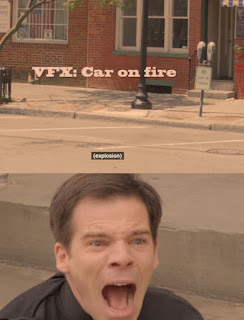I for one am annoyed by our new overlords.
This week, I watched in real time as the latest craze for tech bros caused serious problems for the Science Fiction publication Clarkesworld. I don't know who told all these people that they could make it big through the short story market (clearly they've never seen our pay scale), but someone said something and now Clarkesworld has had to close their submission portal and figure out a better way to screen for AI submissions without punishing human writers.
No solution has yet to be found. At least for Clarkesworld.
And yes, the submission page has a little check box stating that the piece being submitted isn't AI generated work. These grifters don't care.
When I first heard about AI merging into the mainstream, it was through the art world. At first I was a bit middle of the road on my reaction. AI could be a cool new tool to make art depending on the programing and programmer.
 |
| Yes, this is art. Mutt signed his name and everything. |
I quickly changed my mind.
A lot of what these AI programs are doing is stealing other people's art and awkwardly changing it. You might think that that's transformative art, people do stuff like that all the time. Except that some of these AI works are including the original artist's signatures and watermarks in their "art". The person behind the AI then tries to pass this new work off as their own original work without any recognition to the originator. The original artists in question are also not giving their permission for their art to be used.
To make an easier art analogy, it would be like trying to pass off a famous painting like The Mona Lisa as your own work after taking the original canvas and splashing red paint across it. I don't think the Louvre will give you any credit.
Art forgery has always been a problem and experts are often needed to confirm if a piece is real or not. Digital art is still fairly young (as far as art production goes), so the expertise on how to judge it's authenticity is a lot harder. And grifters are always out to make an easy buck.
That brings us to the latest AI target - literature.
This is a space I am active in (not just passively like I am with art). Like creating quality art, writing any form of literary work takes a lot of skill honed over years of crafting. Writer's typically have a distinct voice that is consistent throughout their writing. This is something that is difficult for a computer to replicate and makes AI work stand out to a reader.
Recently, there's been a rush to self publish AI generated children's books. I'm not fully sure if this was a legit experiment or turned into an experiment when the creator started getting called out. Regardless, the children's book (called Alice and Sparkle) was a collaborative work by the human Ammaar Reshi and an AI. Both the art and writing were AI generated. It currently has three stars with reviews either raving about the author's innovation or completely bewildered by the lack of plot and strange art design.
It's currently the subject of a lot of mockery on many areas of the Internet.
Though I haven't read the book, I have seen a few examples of the art work. All I can say is, it's bizarre - almost uncanny. And if that's the art, I shudder to think how off putting the writing is.
I am a writer, not because I think I'll make it big and end up as the next Hunger Games, but because I love telling stories. Even when my work doesn't go beyond my writing groups, I feel great sharing it with others. There also isn't that much money in short stories, self publishing, or even traditional publishing. The vast majority of writers have day jobs.
Tech bros are trying to get rich quick by disrupting a market they barely understand with technology that can't replicate the creativity and voice that goes into these crafts. They have admitted that they don't care if they have to steal data to improve their technology and don't seem bothered by the real humans who are struggling to make their craft their full time jobs. Ten bucks says that we'll start seeing YouTube videos and expensive writing seminars on how to get rich writing stories and making art with AI in the next couple of months.
They are far more likely to just get themselves banned after trying to submit their AI nonsense.
Until next week.
If you enjoyed this post (or it really pissed you off) please like, share, and/or leave a comment. I love hearing from my readers and I hope y'all like hearing from me.
Note: this is a controversial topic and I reserve the right to delete anyone.

